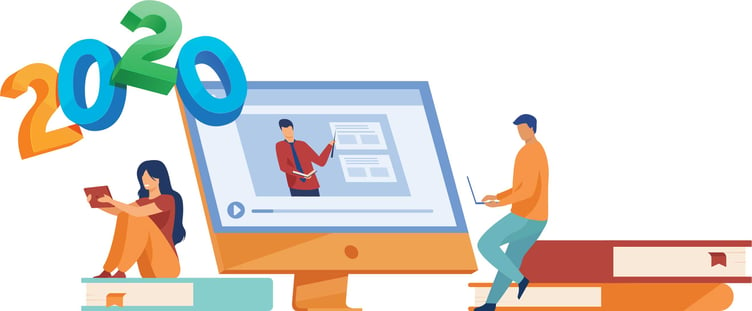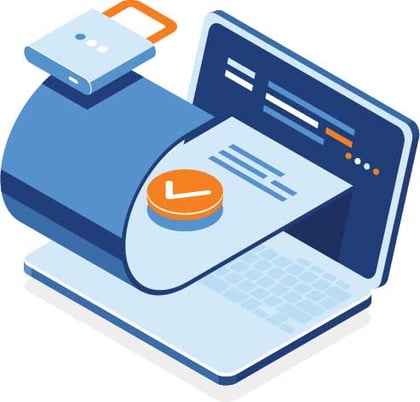Educational Content Providers:
How To Successfully Embrace the Digital Transformation
Introduction
The education industry has certainly undergone significant changes in 2020. The arrival of COVID-19 has effectively put the spotlight on digital education, and it is unlikely that things will return to the way they were prior to the global pandemic. Consequently, content distribution practices have shifted, putting pressure on educational content providers to adapt and revisit their methods.
Successfully adapting to the digital transformation ensures your profits and the general well being of your company will not be at risk. Thus, we have developed this guide to discuss the importance of transitioning to digital as an educational content provider.
We will also delve into the reason why it is important to embrace this change now, and how making digital content a part of your core strategy can be beneficial to your business. Finally, we will illustrate how it is possible for you to transition to digital while still protecting your valuable intellectual property.
- The Importance of Going Digital as an Educational Content Provider
- Why Embrace Online Education as Part of Your Core Profit Strategy Now
- How to Go Digital While Protecting Your Valuable Intellectual Property
- Why is VitriumOne an Ideal Solution for Protecting and Distributing Digital Educational Content
- Conclusion
- The Importance of Going Digital as an Educational Content Provider
- Why Embrace Online Education as Part of Your Core Profit Strategy Now
- How to Go Digital While Protecting Your Valuable Intellectual Property
- Why is VitriumOne an Ideal Solution for Protecting and Distributing Digital Educational Content
- Conclusion
Subscribe to our Blog
The Importance of Going Digital as an Educational Content Provider
In early 2020, the global pandemic caused thousands of schools to close worldwide. According to UNESCO, as of April there were upwards of a billion affected learners (Figure 1). Along with these closures came the realization that schools could no longer accept and distribute physical copies of educational materials. To prevent the spread of the virus, packages containing textbooks, lesson plans, work books, etc. now had to be delivered in such a way that there was no physical contact. Moreover, traditional in-person lessons necessarily gave way to virtual lectures.
Schools, then, were forced to adopt online education practices. Educational content providers whose content was already digitized and ready for immediate distribution were able to continue selling their products to school districts (or school councils in the UK and Europe). However, those whose business relied solely on the distribution of physical copies of their content suffered a significant decrease in their revenue streams.

Even as schools re-opened and returned to in-class lectures, school districts faced pressure from teachers and parents alike to offer more virtual schooling options. The need to ensure education continues regardless of world events is prevalent. Moreover, eLearning offers benefits that go well beyond the ability to learn at home. Online education, as described by Oxford Learning, is customizable and comprehensive.
As explained by Connections Academy, it is customizable insofar as it “fit[s] the school to the student” rather than “fitting the student to the school.” Instead of providing a generic methodology, it offers more flexibility to meet the different learning needs of students. It is comprehensive in the sense that it broadly covers the capabilities and shortcomings of all students. eLearning empowers students to “learn at their own pace” as each individual has the opportunity to approach the material in a way that is in accordance with their capabilities. Additionally, online education fosters an atmosphere for uninterrupted instruction. Less time wasted and fewer distractions gives the student the ability to learn more, and retain knowledge faster. Connections Academy also found that students in virtual schools have better interconnection with family and friends, as well as their instructors.

However, it is erroneous to think that online learning could entirely replace face-to-face instruction. Pedagogy, that is the approach or method utilized by the teacher, has a great impact on students and how they learn. It is not as simple and clear-cut as providing the material and asking students to do the work, and an important part of it is the ability for the teachers to interact on a personal level with each of their students. Moreover, as Rebecca McKeon explained, [students], emotionally, have been affected by not being able to be around their peers” and “do their normal things.” In person learning offers social and emotional benefits to students “that online learning cannot make up for." In addition, said McKeon, relying solely on online learning could promote a lack of accountability for student work:
"I’m not sure how much of the work my students did and how much the parents did, [with in-person teaching] you can hold the [students] a little more accountable and see “what they do independently."
Rebecca McKeon
Perhaps a blended approach to learning offers a combined solution that reaps the benefits of both online and face-to-face education. In this regard, blended learning provides students and teachers alike with the best of both worlds. It facilitates the flexibility and customization of comprehensive online learning and ensures social and emotional interactions for students and accountability for student work. Naturally, with blended learning, even as students go back to school, the demand for virtual schooling and the need for online content is only expected to grow.
Why Embrace Online Education as Part of Your Core Profit Strategy Now
Given the continuous expansion of the demand for online learning, educational content providers are expected to transition to digital in order to meet their customers wants and needs. The digital educational publishing market is
forecasted to grow by USD 6.96 billion (bn) in the next four years (Figure 2), with a significant share of that growth coming from the K-12 segment.
This means that educational content providers selling to the K-12 market must adhere to the newly popularized eLearning model and provide digital copies of what used to be physical learning materials. Failing to do so could result in their company falling behind and ultimately suffering significant losses.

Consider the story of Blockbuster Video as a cautionary tale. According to Forbes, in the year 2000, Reed Hastings brought the idea of an innovative digital streaming service called Netflix to the physical video rental company Blockbuster. Hastings, founder and CEO of Netflix, was interested in forming a partnership that would help Blockbuster transition to an online service in exchange for promotion of the streaming platform in their stores.
Needless to say, Hastings was laughed out of Blockbuster Video’s corporate offices. Blockbuster failed to see the opportunity Netflix did in the impending demand for digital content. Within a decade, Blockbuster had gone bankrupt while Netflix thrived and expanded.
Another prime example is Amazon and their competitor Barnes and Noble. In 2007, Amazon began selling eBooks which were available for instant download to their Kindle reader. Barnes and Noble didn’t latch onto this trend until 2009, meaning their eReader never quite caught on, as by the time they made it available there were already many others. As with Blockbuster, Barnes and Noble failed to understand the demand for virtual products, and their profit margins suffered greatly for it.
To put it bluntly, companies that don’t adopt virtual learning in a timely and successful manner could very well suffer the same consequences as Blockbuster or Barnes and Noble. Being behind the times negatively impacts your shares and profits, as well as your reputation, directly. You have the opportunity now to get ahead of the curve. Don’t wait until it is too late to transition your educational content to digital products.Evidently, there are questions and issues that arise upon deciding to digitize your materials. Perhaps the most pressing one being how to protect your content from unauthorized access. Illegal downloads and peer-to-peer sharing is a very real and serious threat, and it is just as detrimental to your bottom line as not offering digital content in the first place.
How to Go Digital While Protecting Your Valuable Intellectual Property
The biggest obstacle educational content providers face when dealing with online education is protection. Ebook security, for example, is just one of many serious issues content creators encounter in the world of virtual learning. Good eReader reported that there is a yearly increase in eBook piracy, the number of pirated books is higher and higher each year. In 2017 alone “$300 million was lost in author income due to pirated book sales in the United States.” This problem permeates to the UK as well. During that same year, the UK’s Intellectual Property Office found that 17% of all eBooks consumed in the region were pirated.
In recent times intellectual property (IP) has gradually become what CSO Magazine has determined the “lifeblood of every organization.” IP is what you and your team have spent hours creating, it is the product of your minds working together and the time you have invested in this process. Especially as an educational content provider, intellectual property is your most valuable asset, and therefore the resource that is at higher risk of being stolen. Your efforts, then, must be spent on safeguarding your intellectual property, that is, the eLearning materials you sell and license.

The question arises, however: Is there a method to distribute content that effectively protects eBooks, or any other type of eLearning material, from being unlawfully shared with people who did not purchase the rights to access it? Furthermore, Is it possible for educational content providers to guarantee that all of their content can be stored and disseminated safely through the hierarchy of the school system? (i.e school districts, schools, teachers, and ultimately students) without making it difficult for authorized users to access the materials that have been paid for? VitriumOne, a solution powered by Vitrium and its partner, Blue Flamingo, was designed specifically for this purpose.

Why is VitriumOne an Ideal Solution for Protecting and Distributing Digital Educational Content
Content security experts Vitrium, and their software partner Blue Flamingo Solutions, developed VitriumOne as the ultimate product to help educational content providers in the process of digitization.
It provides a solution for content providers seeking to stay ahead of the curve while avoiding common mistakes and challenges when creating and distributing digital content. VitriumOne is a software created with the following parameters at its core:

Conclusion
The current state of affairs, the growing demand for digital content, and the many benefits it presents for teachers and students alike, make virtual learning a permanent solution rather than a temporary fix. It is unlikely that education will revert to solely in-classroom instruction or physical materials, meaning that online education will be present in one form or another moving forward. In this regard, transitioning to digital products should not result in negative consequences for your sales or your reputation. Your digital content must be easily disseminated while remaining secure. With VitriumOne, you will have the peace of mind that your materials are protected while being able to offer ease of access to your customers. Learn more about VitriumOne and how it can help educational content providers protect and distribute their valuable intellectual property.
Learn more about VitriumOne and how it can help educational content providers protect and distribute their valuable intellectual property, request a demo today!
Learn more about VitriumOne and how it can help educational content providers protect and distribute their valuable intellectual property

Curious which DRM solution is best for your business?
CONTACT US
© Copyright 2025 Vitrium Systems Inc.